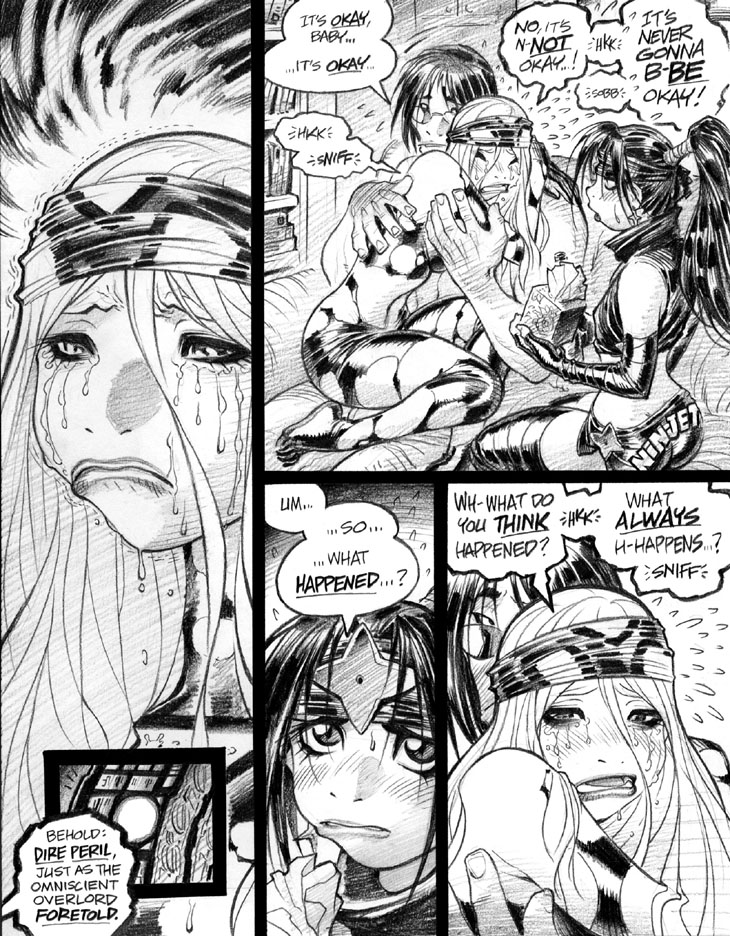Panel 1: Note the ominous dark swirls at the top of the panel, which is an expressionistic background riff I borrowed from manga decades ago. (I vividly recall first using this trope in a panel from the miniseries Dirty Pair: Plague of Angels, in which a pissed-off Yuri looms over Kei, framed against such a “swirlydark” backdrop.) That’s one of the main things that attracted me to manga in the first place, the way that some of my favorite artists would break free of a literalistic depiction of events and use expressive, abstract, or even surreal visual approaches to convey emotional impact. Compare this to the cold, detached, remote, clinical impression I garnered from the French bande-desinée comics I was reading at the time, and it’s no wonder that manga became the key influence on my own work. (Then again, one of the most important influences in my early career was the great Otomo Katsuhiro, whose own comics were heavily influenced by exactly such cold, detached, remote, clinical bande-desinée. Oh, well.)
That’s an oddly distinctive manner I took to rendering the many, many tears spilling down Emp’s cheeks, to the point that it suggests I was possibly ripping off a manga artist’s specific version of depicting tears. (If you’re looking for a bajillion different ways to show people crying, look no further than the field of Japanese comics, which is rich if not veritably chockablock with variations on such lachrymose imagery.) Alas, looking at the panel now, I can’t tell you which mangaka I might have been cribbing from. The possibility even exists that I worked up this technique all on my own, believe it or not.
Note that the technical term for the wee little inset image of the Caged Demonwolf is usually called an “insert panel.” Very handy way to add an extra bit of storytelling without having to burn an entire, separate panel on, say, a “cutaway” shot of the Demonwolf.
Panel 5 (counting the insert panel within panel 1 as its own panel): The close-up of Emp that finishes off this page holds up pretty well, to the point that I find it almost upsetting to see her so obviously distraught and tearstricken.
Note that I said “almost upsetting,” as I myself have all the emotional range and intensity of a piece of 2 X 4, being the burnt-out, half-alive, zombie-like shell of a man that I am. My only moods are several Disney dwarfs: Sleepy, Grumpy, Dopey—and Bashful, I suppose, when I must interrupt my isolated, “hissing recluse” lifestyle to attempt interaction with other humans. In truth, my depiction of Emp’s occasional emotional volatility is drawn in part from my twenty-something experiences of interacting with people who clearly experienced a far more—might I say, dramatically more?—dynamic emotional range than I ever did. While such “feels-intensive” folks undoubtedly nurture a richer and deeper and fuller inner life than I do, I gotta say that the experience appears arduous and even grueling to this emotional flatliner’s introverted eye. (I recall almost blurting in the presence of a certain highly emotive artist friend of mine—male, I feel I should add—“Man, it must be exhausting to be so g-d complicated.”) Rather, I prefer to write about characters who enjoy more dynamic emotional ranges than my own, with Emp being a key example of the trend for me.
-Adam Warren

